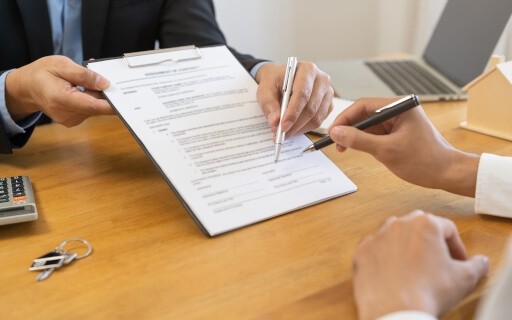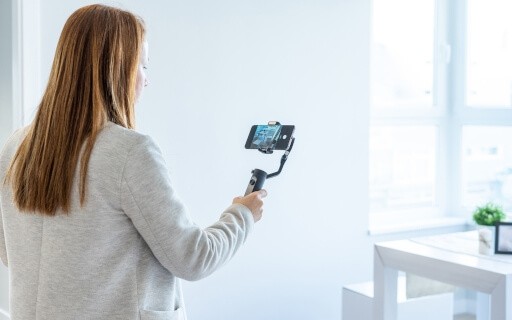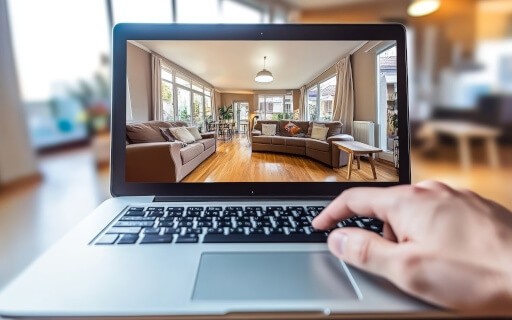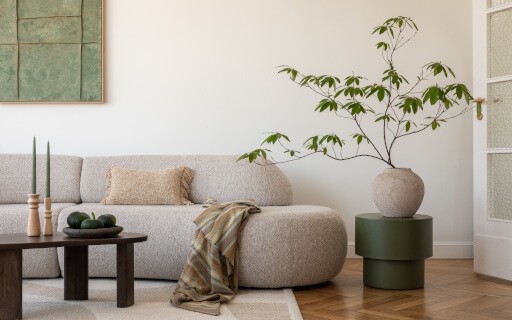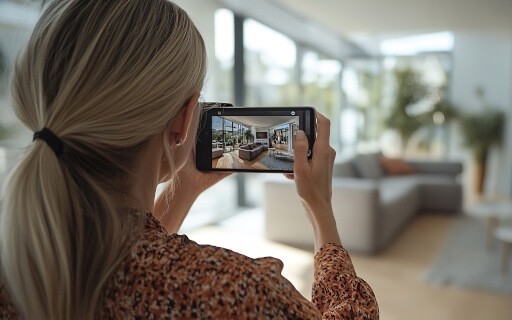
Whether you’re new to renting or a seasoned pro, great photos can make or break your listing. High-quality images don’t just show your space, they sell it. Use this step-by-step guide on photographing your rental to make it stand out and attract the right tenants.
Key Takeaways
Follow this guide on photographing your rental to take eye-catching images:
- Prepare the space
- Get the proper equipment
- Choose the best time of day to photograph
- Avoid glares and reflections
- Shoot multiple angles
- Capture exterior photos
- Edit photos
- Monitor and update listing photos
Prepare the Space
Before you begin, prep your by thoroughly cleaning every room and decluttering. Decide if you would like to stage the home or leave it empty. Furnishing and decorating a room with the right pieces helps potential renters picture themselves living there.
The purpose of staging is to create that emotional connection, so keep the look clean and inviting. Avoid overly bold colors or dramatic statement décor; instead focus on neutral tones and simple accents that appeal to a wide range of renters.
If tenants currently live in your rental home, ask if you can take photos and provide them with 24-hour notice before entering the unit. Ask your tenants to clean up and remove anything personal, such as family pictures, since this could distract potential tenants from imagining themselves living in the space.
Ensure You Have the Right Equipment
While a professional camera can deliver stunning results, you can take great photos of your with a smartphone. Just hold your phone horizontally to get a landscape image of each room.
According to architectural photographer Christiaan Cruz, you should use a tripod for your smartphone or camera. If that’s not an option, Cruz said to, "learn [how] to brace your phone firmly with solid braced arms and torso."
The Best Time of Day to Photograph Your Rental
Natural light makes your home look brighter, larger, and more inviting. Shoot in the early morning or late afternoon for the best glow. Skip rainy or overcast days since they can make rooms feel dark and cramped. If sunlight isn’t an option, turn on all your lights and add lamps for warmth.
Avoid Glares and Reflections
Bright days are perfect for photos, until the sunlight turns harsh and washes out your space. To prevent this and still have well-lit photos, use sheer curtains or partly closed blinds to soften the glare. If reflections stick around, shift your angle or move to another spot until the lighting looks good. Avoid using flash since it can cause harsh reflections and flares.
Shoot From All Angles
Take multiple shots of each room to find the best framing and lighting. Stand in a far corner so you can capture as much of the space as possible. As Cruz advises, keep the camera parallel to the walls and at a comfortable height, about waist level or countertop height; only raise it only for higher countertops.
If you’re using a camera, a wide-angle lens can capture more of the space. Just make sure it isn’t so wide that it creates a fish-eye effect, which can warp the image. Don’t worry about not having a camera as most smartphones have a 0.5x lens that’s perfect for photographing an entire room.
Capture the Exterior
Exterior shots help potential renters picture where they’ll live and get a feel of the neighborhood. Cruz recommends, "Find the time of day where the sun shines on the front of your home nicely, then take shots from the center straight on both corners. Try to hold your camera higher, even above your head, to get it more center-lined with the building."
If your property has outdoor features like a backyard, patio, or pool, follow the same steps so renters can see everything your home offers. Watch for shadows from nearby trees or buildings, especially near sunset. If heavy shadows creep in, try shooting at sunrise instead, when the light comes from the opposite direction.
Edit and Enhance
Once you’ve captured your shots, take time to refine them. Adjust brightness, contrast, and color balance so your photos look clean and inviting. Aim for subtle edits that make your space shine without looking fake, such as minimal adjustments to the natural light and true-to-life tones.
Monitor and Update
After uploading your photos, keep an eye on your listing’s performance. If views or inquiries are low, refresh your images or consider hiring a professional photographer. Even if your property is performing well, it’s a good practice to update photos after any major changes or every 6–12 months.
Strong visuals are the key to attracting renters. Follow these photography tips to boost your listing’s visibility and connect with the right tenants faster.
Let Renters Explore Your Property in 3D
3D tours aren’t just for tech experts, you can create one right from your phone. Record the tour while you’re taking photos, since the same lighting and composition tips apply to both.
To enjoy the benefits of Matterport 3D tours, upgrade to a Premium listing on Apartments.com. Virtual tours help renters picture themselves in your space, boost engagement, and expand your applicant pool, all with one powerful feature.
This article was originally published on September 14, 2023.
FAQ
What rooms and features should I always photograph in a rental listing?
Capture every major living space that helps renters visualize daily life, like the living room, kitchen, bedrooms, bathrooms, and laundry areas. Don’t skip features that set your rental apart, such as patios, backyards, garages, or community amenities. Highlight any recent upgrades or standout finishes such as stainless steel appliances, hardwood floors, or smart thermostats.
How do I take photos of dark spaces?
In rooms with little to no natural light, add lamps or other light sources. You can also adjust your camera’s exposure or use your phone’s night mode to brighten the shot.




